SEL Strategies for Students with Special Needs: Enhancing Social-Emotional Learning in Inclusive Classrooms
Explore proven SEL strategies for students with special needs and discover how inclusive classrooms can nurture social-emotional learning for all learners.
Introduction
Social-emotional learning (SEL) is more than just a trendy concept—it’s a cornerstone for academic success, positive relationships, and lifelong wellbeing. In inclusive classrooms, where students of diverse abilities learn together, implementing effective SEL strategies for students with special needs becomes even more critical. Educators are continually searching for ways to accommodate and empower every learner, making SEL a priority for both academic and personal growth. In this article, we will explore evidence-based strategies, practical tips, and real-world examples to foster social-emotional progress in inclusive environments.
The Importance of SEL in Inclusive Classrooms
Inclusive classrooms bring together students with and without disabilities, facilitating learning experiences that are diverse and dynamic.For students with special needs, SEL provides essential skills such as self-awareness, emotional regulation, interaction, and social skills.
- Boosts confidence and self-esteem
- Improves peer relationships and collaborative abilities
- Reduces behavioral challenges through effective coping mechanisms
- Enhances empathy and understanding among all students
- Supports academic achievement by creating a positive learning environment
With tailored SEL interventions, inclusive classrooms can help every student flourish—academically, socially, and emotionally.
Challenges Faced by Students with Special Needs
While SEL is beneficial for all, students with special needs often face unique challenges:
- Sensory sensitivities making group activities overwhelming
- Communication barriers such as limited verbal skills or choice communication needs
- Difficulty in understanding social cues and emotional expressions
- Anxiety and frustration when routines change or expectations are unclear
- Behavioral issues as a means of communicating unmet needs
Recognizing these challenges is the first step toward effectively supporting students through targeted SEL approaches.
Effective SEL Strategies for Students with Special Needs
What does SEL look like for students who need extra support? Here are some highly impactful,research-backed strategies for enhancing social-emotional learning in inclusive classrooms:
1. visual Supports
- Visual schedules: Offer predictability and reduce anxiety by outlining routines.
- Emotion charts: Help students recognize and label their feelings.
- Social stories: Illustrate expected behaviors and step-by-step actions in various social situations.
2. Explicit SEL Instruction
- Direct teaching: use structured lessons to teach concepts like empathy, self-regulation, and conflict resolution.
- Role-playing: Practice real-life scenarios to model appropriate responses.
- storytelling: Use literature or narrative to spark discussions about emotions and social norms.
3. Positive Behavior Support (PBS)
- Clear expectations: Consistently communicate behavior guidelines.
- reinforcement: Use praise, tokens, or choice as rewards for positive social interactions.
- Restorative practices: Encourage repair of relationships through mediated conversations.
4. Collaborative Group Activities
- Cooperative learning: Small teams promote interaction and empathy-building.
- Peer buddies: Pair students to foster inclusive friendships and mutual support.
- Structured games: Integrate turn-taking, sharing, and emotion management into classroom play.
5. Mindfulness and Self-Regulation Exercises
- Guided breathing: Simple exercises to help manage stress and refocus attention.
- Movement breaks: Provide sensory regulation opportunities with yoga, stretching, or short walks.
- Calm-down corners: Designate quiet spaces where students can regain composure.
6. Family and Community Engagement
- Home-school communication: Share strategies and progress with families to reinforce learning at home.
- Community partnerships: Engage local organizations in SEL initiatives for real-world learning.
Practical Tips for Implementing SEL in Inclusive Classrooms
- Assess individual strengths and needs: Use IEPs (Individualized education Programs) to inform SEL goals.
- Foster an accepting classroom culture: Celebrate diversity and encourage mutual respect.
- include student voice and choice: Allow students to help set classroom rules and participate in SEL decisions.
- Offer multi-modal instruction: Combine visual, auditory, and kinesthetic activities for varied learning styles.
- Monitor progress: Use checklists,observations,and student self-assessments to adjust strategies.
consistency and patience are key—meaningful change takes time,but every step forward is progress worth celebrating.
Real-Life Examples: SEL in Action
Case Study 1: Using Social Stories for Emotional Regulation
At Jefferson Elementary, a first-grade teacher noticed that a student with autism struggled with transitions. By implementing personalized social stories and a visual schedule, the student began handling routine changes with less anxiety and fewer outbursts, setting a positive example for peers about adapting to new situations.
Case Study 2: peer Buddy System
In a fifth-grade inclusive classroom, teachers set up peer buddy partnerships focused on cooperative projects.A student with Down syndrome gained confidence communicating with classmates, while her buddy learned empathy and gratitude for different learning styles.Both academics and friendships flourished.
Benefits of SEL for students with special needs (and All Learners!)
- Enhanced social skills: Students interact more positively and resolve conflicts effectively.
- Improved self-awareness: Learners recognize their emotions and triggers, leading to better self-control.
- Greater academic engagement: A safe, supportive environment fosters curiosity and persistence.
- Healthier relationships: SEL builds bridges of understanding among diverse student groups.
- long-term resilience: Emotional intelligence helps students adapt to challenges both in and out of school.
Conclusion
Integrating SEL strategies for students with special needs isn’t a one-size-fits-all approach—it’s a dynamic, personalized journey that benefits the entire classroom community. By leveraging visual supports, explicit instruction, positive behavior reinforcement, and building meaningful connections, educators can create inclusive classrooms where every child feels valued, connected, and empowered. When SEL becomes a shared priority,all students—regardless of ability—gain the tools they need to thrive academically,emotionally,and socially.
Start small, stay consistent, and remember: every act of support and understanding paves the way for a brighter, more inclusive future.

